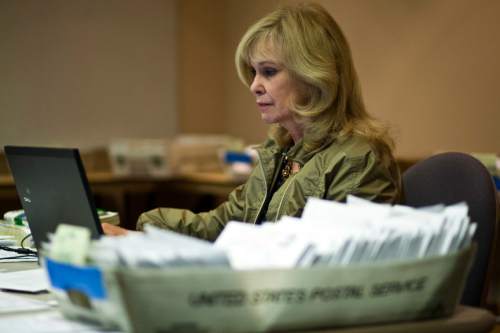This is an archived article that was published on sltrib.com in 2016, and information in the article may be outdated. It is provided only for personal research purposes and may not be reprinted.
Come on, Utah. It's time to vote. What are you waiting for? An engraved invitation?
County clerks from around the Beehive State have dumped nigh onto 1 million ballots into the mail. In 20 of the state's 29 counties, the primary election is basically a mail-in arrangement. Though there will be other, more traditional options on or near the official Election Day of June 28.
OK. So they aren't exactly gold leaf on calfskin parchment. But every registered voter in those counties is supposed to have his or her own personal ballot to open, study, regard, ponder and return, and have it in plenty of time to make a fully thought-out decision.
The idea — and it is a very good one — is to make it easier to vote, and to vote intelligently. No more wondering where your polling place is, arranging your day, finding a parking place, standing in line, only to face a ballot list of names you've never heard of before.
There is an argument to be made that voting shouldn't be too easy. That the obstacle course described above winnows out the dilettantes. That our elections, even at their most inconvenient, would be attractive indeed to people living in nations where voting is rare, dangerous or both.
Still, every level and division of government is only as good and useful as its legitimacy in the public's mind. And the more people who participate in the process, at least to vote, the more we have a society where people feel some ownership of, and responsibility for, their communities, states and nations.
Broader electoral participation also helps draw parties and politicians away from the extreme positions sometimes favored by the most active blocks of voters and steer them toward more moderate, inclusive policies.
The belief that voting by mail boosts turnout is supported most strongly by the recent history of municipal elections in Salt Lake City. There, turnout went from 24 percent in 2011 to 13 percent in 2013 to 54.6 percent last year.
The fact that the 2015 ballot also included a tightly fought mayor's race was also a factor in the higher turnout, surely. But even close races are more justly resolved when they are settled by the largest possible percentage of the electorate, rather than a tiny sliver of a tiny sliver.
Republican voters are nominating candidates for governor and 3rd District member of Congress. Democrats are choosing someone to run for the U.S. Senate. Everyone, party affiliated or not, has state and local school board contests to decide.
These decisions matter. The state and these counties have made it easier for you to have your say. Don't blow it.



